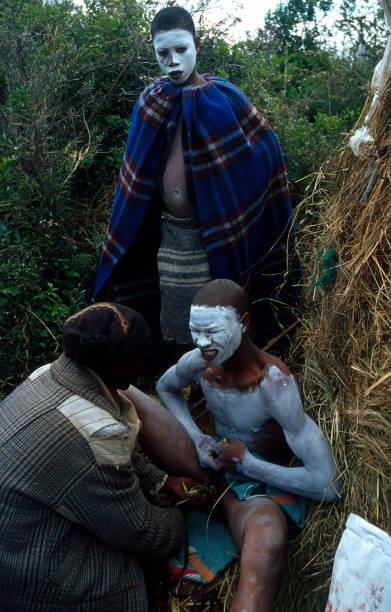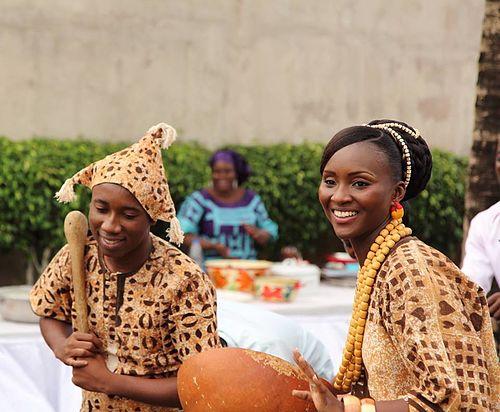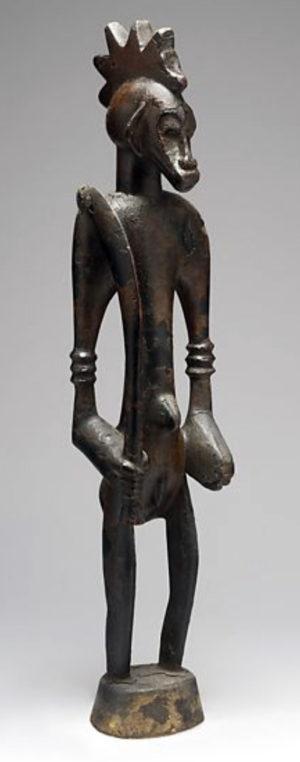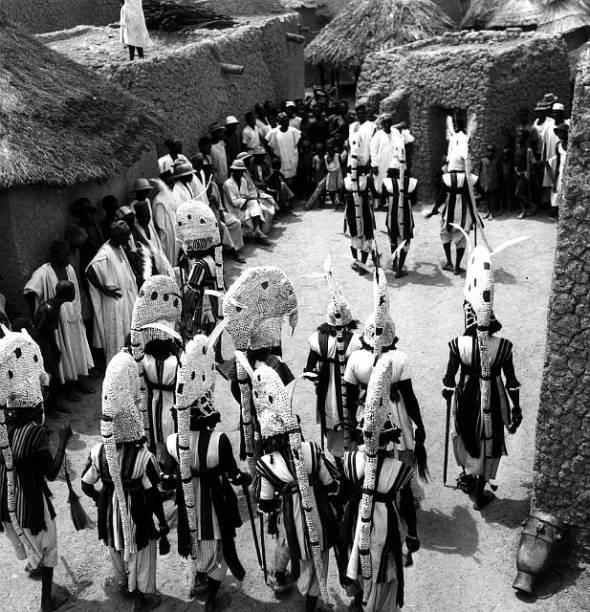Across several cultures of the world, the passage from childhood to adulthood is often marked by initiation rites or ceremonies. Separation from the family and other-sex peers, initiation into adulthood, instantiation of male dominance and aggression, and demonstration of peer group and political loyalties are all seen in initiation rituals ¹. This is a rite of passage that marks an entrance into a group or society. In the spiritual sense, a male child still remains a boy, even upon maturity. It is not until the young boy undergoes seclusion, where he learns about manhood, courage, and responsibility, that the community sees him as a man who can now take part in certain community decisions. It can also signify a transformation in which the ‘initiate’ is reborn into a new role through ritual and instruction.
Initiation rites connect people with the divine, ancestors, and sacred traditions. It binds the present generation to the past (the ancestors) and to the future (through the moral training of the youth). This rite is practiced as a religious duty, ensuring that each person takes their rightful place within the divine order of the world. These rites differ across several indigenous traditions and can be interlinked to a simultaneous death and rebirth, as the old identity (uninitiated) drops away in ascension to the next.
At its core, the crossover from childhood to adulthood is often marked by certain biological changes in both male and female physical appearance. A rite of passage may accompany these developmental changes – for males, signs such as the deepening of the voice and the appearance of pubic hair; for females, the onset of menses (menstrual cycle) and the emergence of breast buds, often described as being “the size of palm nuts.” The onset of menarche in girls and the ability to ejaculate seminal fluid in boys constitute major milestones marking the end of childhood and the beginning of the biological ability of boys and girls to have children.
To begin the pubertal rites, the initiates are first separated from the family and ordinary society, after which they undergo instructions and advice for their expected new roles in society.
Instruction in traditions, skills, dress, speech, deportment, and morality is given over a period of months or years. Commonly, instruction is first given at this time in matters of religion that have therefore been kept secret and initiates may at this time be expected or required to commune with the supernatural, sometimes by means of revelatory trances induced by fasting, violent physical exertion, or the consumption of plant substances that produce hallucinations or otherwise alter the sensibilities ². Among several indigenous communities, these rites serve as a means of remembrance, to honor the forefathers by showing that the living continue to uphold sacred traditions.
These rites differ from community to community and are socially prescribed to officially mark a transition from childhood to adulthood by offering a ceremony, ritual, or other experience that is intended to either prepare young people for the roles and responsibilities of adulthood or simply officially declare that the young person is now an adult.
Circumcision is among the most commonly practiced rites of passage for boys in many African societies, particularly outside the southern African region ³. The practice of circumcising male children originated as early as 6000 BCE in ancient Egypt, and over time, it spread to various other parts of the world.
Among the Xhosa people of South Africa, circumcision is practiced as a form of sacrifice (death and rebirth). Ulwaluko initiation rites, as known by the Xhosa people, center on circumcision as a symbol of the child’s death and rebirth.

The physical pain of circumcision and the trials of isolation represent the ordeals of this death, and on successful completion, he becomes a full adult man with responsibilities in the society (hence; rebirth). When a boy feels ready for initiation, he announces it to his family through the song ⁴. The sacrifice lies in the bloodshed during the circumcision ritual. Until they undergo circumcision, young boys are regarded as outsiders and are not fully accepted as men.
Poro Rites of the Senufo People

Across the many African communities that observe initiation rites, the Senufo people stand out for their well-established and respected practices. The Indigenous Senufo people, primarily concentrated in the Northern Côte d’Ivoire (also Ivory Coast), Southeastern Mali, and Western Burkina Faso, usually fall within four societies in their culture: Poro, Sandogo (also called Sande; For women) ⁵, Wambele, or Tyekpa. While all the societies fill particular roles in the governance and education of the Senufo people, the Poro society is by far the most important, serving as both a spiritual institution and a system of rules that guides young boys into adulthood. This rite trains the men for life’s trials and helps them to acquire self-control ⁶. The souls of the ancients are venerated and all the acts of Poro manifest the ancestors’ will. Generally, Poro functions and supervises the initiation of young boys into adulthood while maintaining the continuity of both religious and historical traditions.
The Poro society, along with the Sande, plays a role in defining and maintaining social order, roles, and values. Some say it was introduced by the Mane people, a warrior group who migrated to the same region from Sudan circa 1000 AD. What is clear is that both societies have long histories, preserved through oral tradition and ritual. Their customs are fiercely protected by secrecy ⁷.
In Northern Côte d’Ivoire (Ivory Coast)

In the Northern Côte d’Ivoire, the Poro Society is recognized as a secret with its own rituals, masks, and artistic traditions, distinct from Poro societies in other regions. Before initiation among the Senufo people, a boy is regarded as a child not yet prepared to shoulder the spiritual responsibilities required of adult men in the community. Senufo boys start taking part in the initiation rites at the age of seven, and at about 28, they will be fully initiated and respected elders in their communities ⁸.
The young Senoufos (often boys between 7 and 14 years old) are physically and symbolically removed from society. They are taken to a secluded location, a sacred grove, also called the sacred woods since it harbors the souls of the ancestors. This sacred space ultimately becomes their home during the training period.
The initiates spend weeks and even months together in the secluded groves. During this time, they develop survival skills and learn about the ancestors that started the practice, the spiritual forces guiding it, and the intellectual foundation to prepare them for adulthood. Senior Poro members, appointed under the authority of Nerejao — an ancestress revered as the spiritual head of the Poro society, are responsible for instructing initiates in the aforementioned teachings and duties involved with Poro. While in the grove, whatever happens is largely secret to them. This is so because an oath of secrecy was taken by each initiate before his seclusion, which, upon defiance, would subsequently bring about the death of a close relation. Their secrecy has helped the Senufo people to preserve their culture in times of war and political pressure.

Always after months or years of seclusion, the initiates who have undergone all stages of initiation return to society with a new identity, and a big celebration follows. The whole community takes part in the festive. The young women perform the Ngoron dance in honor of the new male initiates, celebrating their successful transition into adulthood.
As the celebration dawns, the initiates proceed to a ritual hut at the edge of the sacred grove. Each initiate walked in a line, accompanied by either his wife or sister, who carried a specially carved ceremonial chair. This chair, later kept in the initiate’s home, served as a visible symbol of his full integration into society.
The Continued Relevance of Initiation Rites
To date, initiation rites remain one of the most practiced expressions of spiritual and social transformation in traditional societies. These rites differ among communities and far more than symbolic ceremonies, they mark the passage from one stage of life to another, typically from childhood to adulthood, and carry with them the weight of communal identity and sacred responsibility. Spiritually, initiation connects the young child to the ancestral realm and the unseen forces that govern life. In many communities, it remains a respected path to personhood, especially among the indigenous communities like the Senufo People, who continue to see Poro initiation as the spiritual backbone of the community.
References
¹ Wikipedia contributors. (2025, May 29). Initiation. In Wikipedia, The Free Encyclopedia. Retrieved June 26, 2025, from https://en.wikipedia.org/wiki/Initiation
² Bobby C. Alexandra, Edward Norbeck. Initiation rites. In Encyclopedia Britannica. Retrieved June 26, 2025, from https://www.britannica.com/topic/rite-of-passage/Initiation-rites#ref538068
³ Munthali AC, Zulu EM. The timing and role of initiation rites in preparing young people for adolescence and responsible sexual and reproductive behaviour in Malawi. Afr J Reprod Health. 2007 Dec;11(3):150-67. PMID: 18458746; PMCID: PMC2367147.
⁴ https://en.wikipedia.org/wiki/Circumcision_in_Africa
⁵ https://en.wikipedia.org/wiki/Senufo_people
⁶ Spiritualité Autochtone. Senoufo People: funeral rites. https://peuplesautochtones.com/senoufo-people-funeral-rites/
⁷ Oyedokun, O. D. (2025, April 30). Poro and Sande: The secret societies of West Africa. Africa Rebirth. Retrieved June 26, 2025, from https://www.africarebirth.com/poro-and-sande-the-secret-societies-of-west-africa/
⁸ Neuenhofer, C. (n.d.). Poro initiation ceremony in Korhogo, northern Côte d’Ivoire [Photograph]. PBase. Retrieved June 26, 2025, from https://pbase.com/neuenhofer/poro_initiation_ceremony_in_korhogo_cote_ivoire









